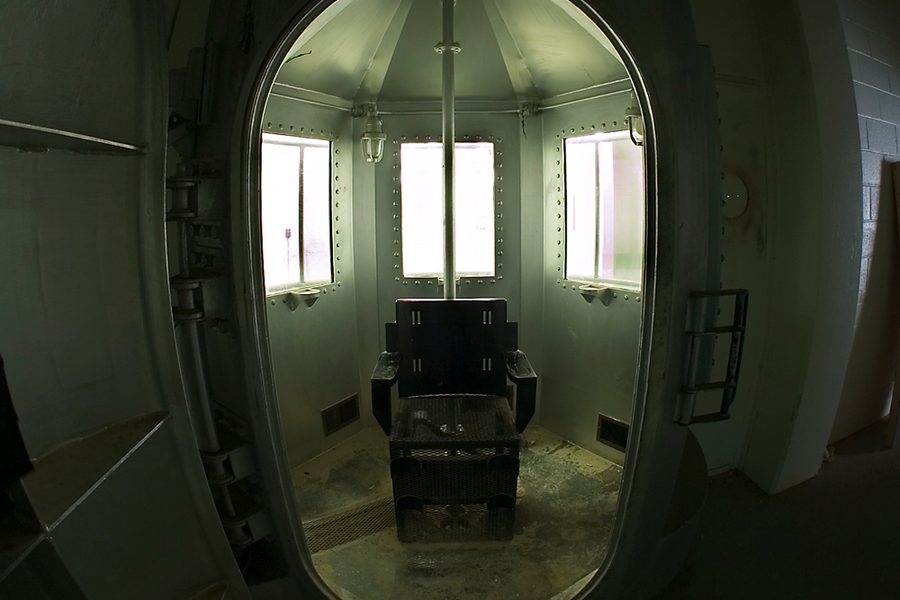Judge says States Carrying out Death Penalty “Committing a Horrendous Brutality on our Behalf”
George Lavender

A federal judge in Arizona delivered his own damning verdict on America’s death penalty system on Monday, just one week after another judge in California ruled that state’s execution process amounted to “cruel and unusual punishment.” (For more context see The Prison Complex interactive timeline, including the recent California ruling here).
“Botched” executions, most recently in Oklahoma, as well as increased difficulty obtaining the necessary drugs have prompted renewed debate about the use of the death penalty in the US, and of lethal injection in particular.
As reported by The Guardian, Judge Alex Kozinski’s public criticism came in a somewhat surprising form:
Paradoxically, Kozinski’s radical critique of the modern death penalty is contained in a dissent to the latest ruling from the ninth circuit appeals court that in effect prevents the state of Arizona from carrying out an execution on Wednesday. The court, with Kozinski dissenting, on Monday declined to re-hear the case of Joseph Wood, who had been scheduled to die by lethal injection for the 1989 murders of his estranged girlfriend, Debra Dietz, and her father, Eugene Dietz, in Tucson. Continue reading…
The court’s denial, with Kozinski dissenting, prevented the state of Arizona from moving ahead with Wood’s execution. At the time Kozinski said he had “little doubt” the decision would be overturned by the Supreme Court justices. He was proven right on Tuesday.
Kozinski said that the nationwide trend to switch to lethal injection from other forms of execution had been “misguided” and that “subverting medicines meant to heal the human body to the opposite purpose was an enterprise doomed to failure.” Use of lethal injection was first proposed in New York back in 1888 but rejected in favor of electrocution. Oklahoma became the first state to pass a law allowing for lethal injections in 1977, and five years later Texas became the first state to carry out an execution.
In his dissent, Kozinski referred to Judge Cormac J Carney’s ruling last week in Orange County that California’s death penalty was unconstitutional. Carney ruled California’s process was too long and uncertain or as Kozinski put it “old age, not execution, is the most serious risk factor for inmates at the San Quentin death row.” As the Los Angeles Times reported 900 people have been sentenced to death in California since 1978 but only 13 have been executed.
Carney, an appointee of former President George W. Bush, said the delays have created a “system in which arbitrary factors, rather than legitimate ones like the nature of the crime or the date of the death sentence, determine whether an individual will actually be executed,” Carney said.
In overturning Jones’ death sentence, Carney noted that the inmate faced “complete uncertainty as to when, or even whether” he will be executed.
The “random few” who will be executed “will have languished for so long on Death Row that their execution will serve no retributive or deterrent purpose and will be arbitrary,” Carney said. Continue reading…
California’s last execution was carried out in 2006. That year a federal court ruled that the state’s execution protocol “create(d) an undue and unnecessary risk that an inmate will suffer pain so extreme that it offends the Eight Amendment.” The US Supreme Court has regularly upheld the constitutionality of the death penalty ever since 1879, but in recent decades it has imposed greater restrictions on the circumstances under which capital punishment can be imposed. As The Economist reports Carney described California’s death penalty system as “uniquely dysfunctional.”
Legal observers are surprised by the broad sweep of the ruling but divided about its potential impact. For James Ching, a former deputy attorney general in California, Judge Carney’s opinion is “quixotic” and errs by attributing all the tarrying to California state courts when federal courts are responsible for “46.2% of the total delay and dysfunction”. The Ninth Circuit Court of Appeals, Mr Ching suggested, will likely regard Judge Carney’s decision sceptically when the state appeals.
But Gil Garcetti, a former Los Angeles County district attorney, has said the Jones ruling is “truly historic” and demonstrates that “the death penalty is broken beyond repair.” California may have the largest and slowest-moving death row in the country, but it is not the only state where condemned prisoners are more likely to die of old age than be executed. The central point in Judge Carney’s opinion, says Diann Rust-Tierney, head of the National Coalition to Abolish the Death Penalty, is “not simply the length of time” between conviction and execution. “It is the unpredictability.” Continue reading…
In an earlier article The Economist described “the slow death” of the death penalty in the US. Support for capital punishment is down from 80% in 1994 to 60% in 2013, according to a Gallup poll.
Several states have recently moved to permit other forms of execution. In May, Tennessee’s Governor signed into law a bill allowing increased use of the electric chair. Legislators in other states have raised the possibility of reviving the gas chamber and firing squad as alternative options.
In his dissent Kozinski declared that “if some states and the federal government wish to continue carrying out the death penalty, they must turn away from this misguided path and return to more primitive — and foolproof — methods of execution.” In these cases, he wrote, the guillotine was probably the best option but “seems inconsistent with our national ethos. And the electric chair, hanging and the gas chamber are each subject to occasional mishaps.” Instead he suggested that if state’s were to continue carrying out executions, the firing squad seemed the best option. Utah and Oklahoma are the only two states to still have firing squad as a means of execution.
Eight or ten large-caliber rifle bullets fired at close range can inflict massive damage, causing instant death every time. There are plenty of people employed by the state who can pull the trigger and have thetraining to aim true. The weapons and ammunition are bought by the state in massive quantities for law enforcement purposes, so it would be impossible to interdict the supply. And nobody can argue that the weapons are put to a purposefor which they were not intended: firearms have no purpose other than destroying their targets.
Firing squads “can be messy” he opined “but if we are willing to carry out executions, we should not shield ourselves from the reality that we are shedding human blood.”


